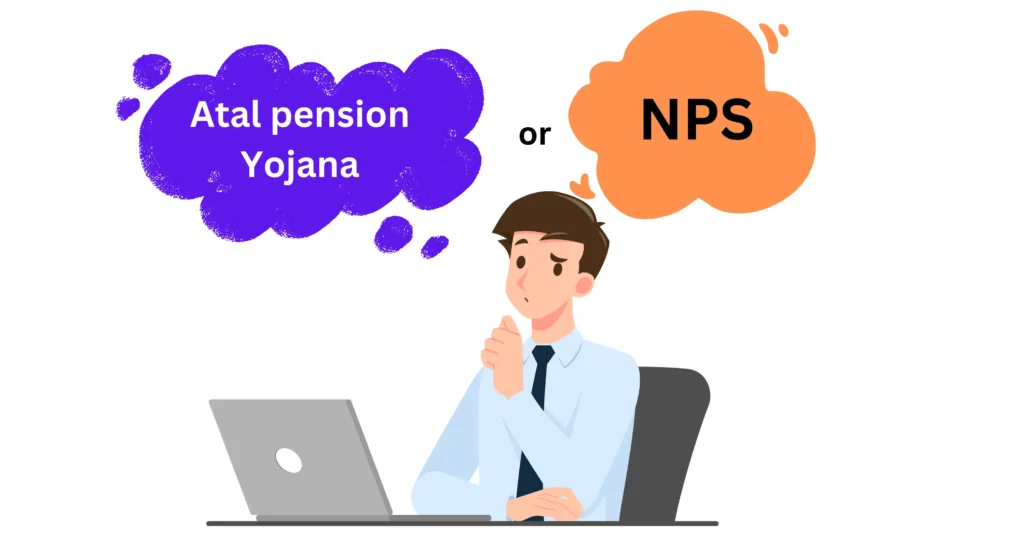I recently started thinking about my retirement planning. Like most people, I want a secure income during my old age. As I explored options, I came across two popular government schemes like Atal Pension Yojana (APY) and the National Pension System (NPS).
Both look promising, but choosing the right one feels tricky. If you’re also in the same boat, let’s break down the differences to make the decision easier and read our difference between Atal Pension Yojana and NPS guide.
For a detailed guide on each scheme, you can check out our articles:

Difference between Atal Pension Yojana and NPS
Atal Pension Yojana (APY): This scheme was launched in 2015, APY scheme is mainly designed keeping in mind the workers of the unorganized sector. It guarantees a fixed monthly pension after retirement, based on the contributions made by the employees during their tenure.
National Pension System (NPS): First launched in 2004 for government employees and expanded in 2009 to all citizens of India, National Pension System (NPS) is a market-linked retirement savings scheme. It allows subscribers to build a retirement corpus and offers flexibility in investment options.
Eligibility and Target Audience: Who Should Choose Each Scheme?
| Feature | Atal Pension Yojana (APY) | National Pension System (NPS) |
|---|---|---|
| Age Limit | 18 to 40 years | 18 to 70 years |
| Target Audience | Unorganized sector workers, low-income groups | Open to all citizens, including salaried and self-employed individuals |
| Income Requirement | No fixed minimum income; designed for economically weaker sections | No income cap; flexibility for all income groups |
Pension Structure: Guaranteed Pension vs. Market-Linked Returns
| Feature | APY | NPS |
|---|---|---|
| Pension Guarantee | Fixed pension (₹1,000–₹5,000/month) based on contribution | No fixed pension; depends on corpus and market performance |
| Government Contribution | 50% of contribution for eligible subscribers for the first 5 years | 14% of basic salary for government employees |
Key Point: APY guarantees a pension, making it suitable for risk-averse individuals. NPS, being market-linked, offers the potential for higher returns but with some risk.
Contribution Details: Fixed vs. Flexible Contributions
| Feature | APY | NPS |
|---|---|---|
| Contribution Type | Fixed amount based on chosen pension | Flexible; subscriber decides amount and frequency |
| Return Type | Fixed pension | Market-linked returns based on chosen fund performance |
| Investment Management | Managed entirely by the government | Choice of fund managers and investment options |
Tax Benefits: Saving More on Taxes
Both schemes offer significant tax savings:
- APY: Tax benefits under Section 80CCD(1), up to ₹1.5 lakh annually.
- NPS:
- Deductions up to ₹1.5 lakh under Section 80C and 80CCD(1).
- Additional deduction of ₹50,000 under Section 80CCD(1B).
Withdrawal and Maturity: When Can You Access Your Funds?
| Feature | APY | NPS |
|---|---|---|
| Maturity Age | 60 years | Flexible, but recommended at 60 years |
| Premature Withdrawal | Allowed only in cases like death or terminal illness | Partial withdrawals allowed for specific needs (education, health, etc.) |
| Annuity Requirement | Full corpus converted to pension | 40% of the corpus must be used to purchase an annuity |
Risk and Returns: Which Scheme Is Safer and More Profitable?
- APY: Risk-free; pension is guaranteed.
- NPS: Returns are tied to market performance, offering higher growth potential. NPS typically yields 8–10% annually, depending on fund performance.
Which Scheme Is Right for You? Choosing the Best Option
| Choose APY If… | Choose NPS If… |
|---|---|
| If you are from the unorganized sector with a low or irregular income. | If you seek flexibility and potentially higher returns for retirement savings. |
| If you want a guaranteed, fixed pension after retirement. | If you are comfortable with market-linked investments and can handle moderate risks. |
| If you prefer a simple, government-managed pension plan. | If you want control over investment decisions (e.g., equity vs. corporate bonds). |
Disclaimer:
This article is for informational purposes only and should not be considered financial or investment advice. Please consult with a certified financial advisor or refer to the official websites before making any decisions.
Official Sources and Resources
To make informed decisions, refer to these trusted sources:
- Atal Pension Yojana: PFRDA Official Website
- National Pension System: NPS Trust Website
Conclusion
Choosing between Atal Pension Yojana (APY) and the National Pension System (NPS) depends on what you need for your retirement. If you want a simple, no-risk plan with a fixed pension, APY is a great option, especially for those working in the unorganized sector.
On the other hand, if you prefer more flexibility, better tax benefits, and the chance to grow your savings through market-linked investments, NPS might be a better fit. The right choice depends on how much risk you’re willing to take and your long-term financial goals.


